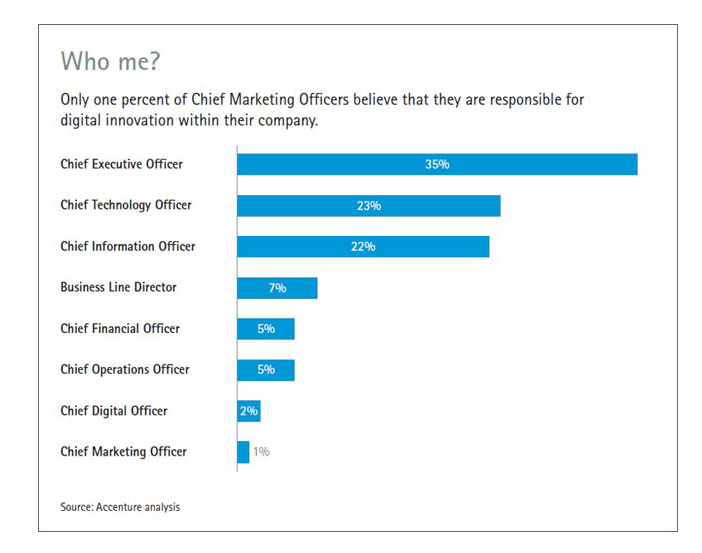The rise of the DD-CMO: How data-driven CMOs are maximizing performance
Contributor Jim Yu feels CMOs are challenged with balancing immediate results and long-term strategy. He outlines ways to incorporate accessible and insightful data to move the performance needle
 The role of the modern CMO continues to evolve as it envelops new industry trends.
The role of the modern CMO continues to evolve as it envelops new industry trends.
According to Forbes, marketing contributes 50 percent of all enterprise value, and the task list for a CMO often extends beyond its traditional remit and into the realms of customer experience, data strategy and change management across the business.

This makes it an incomparably challenging position, tasked with creating steady profitability from an ever-changing landscape.
There are numerous cautionary statistics about the average tenure of a CMO when compared to their C-suite colleagues. The CMO title has evolved in some quarters to Chief Growth Officer to reflect its core objective of commercial development. These facts underline the role’s significance rather than diminishing it, however. Any shifts in title or changes in personnel are symptoms of an unerring desire to get this role right. It is too important to be allowed to stagnate.
The key challenges I see for CMOs through this year and into 2019 will include:
- Using AI to derive and scale insights.
- Leading the organization’s push toward true customer-centricity.
- Accurate personalization across all consumer touch points.
- Storytelling through content across digital channels.
- Developing an efficient, effective martech stack.
- Data accuracy, privacy and security.
- Proving the ROI on ad tech through its convergence with martech
The importance of data can hardly be understated as a common thread through these trends, with the vast majority of data created never analyzed. The CMO can go some distance toward overcoming their challenges by going against this trend. To be “data-driven” means more than just referencing data points to substantiate strategic decisions, however. It means implementing rigorous processes, working with the right technology partners and maintaining a focus on genuine consumer problems that the business can solve.
Using data to develop consumer understanding
The modern CMO’s role incorporates aspects of numerous specialties, including information technology, marketing strategy and data analysis. This is all undertaken with the aim of leading a customer-centric strategy, both internally and externally. Many businesses are customer-focused, but to be customer-centric is another matter altogether.
The data-driven CMO begins with an objective view of the landscape before assessing the points at which their brand intersects with current and future market demands. This must be combined with an empathetic view of the issues consumers are facing, before turning attention to the solution a brand can provide.
There are few shortcuts in this arena. The empowered consumer can see through brittle brand promises, and the savvy CMO is aware of this. In a networked society, opinions (both positive and negative) can be spread globally at the click of a button. Moreover, as influencers accrue more power over public opinion, the focal points for the brand’s communications strategy can change too. The fragmentation of customer personas presents another challenge, as people move across platforms, devices, and accounts through each day. They leave a trail of data when they do so; capturing and interpreting it is the hallmark of the sophisticated CMO.
This data creates a model of human behaviors, and although these models are imperfect, their accuracy is increasing. Feedback is instantaneous in the digital age, but without context, these statistics are nothing more than noise. Rather than chasing these trends, the data-driven CMO can maintain focus on the underlying demands and frustrations of consumers. This provides a contextual framework against which real-time performance metrics can be evaluated.
Creating a common business language through data
The responsibilities of a CMO are difficult to pin down; some definition can be found in conjunction with other roles in the organization. The relationship between CMO and CIO is increasingly important, with some responsibilities split between the two. The opportunities for collaboration here are self-evident, but the basis for this must be a shared language. Evidence suggests that this clarity is not as widespread as it should be within most businesses.
An Accenture study found that only 1 percent of CMOs believe they are responsible for digital innovation within their company:
This lack of transparency is easier to understand than to resolve. Given the range of skills, experiences and personalities that are typically incorporated in a C-suite staff list, it is only natural that there should be diverging opinions and perspectives. Where many of these other roles are fixed in their outlook, the CMO has the advantage of fluidity.
This brings an opportunity to create a common language based on shared business objectives. Although the CMO and the CIO may have different ways of contributing toward these objectives, they can frame their activities based on the impact they are expected to have on hitting the company’s goals. By understanding the perspectives of each department, the CMO becomes a powerful interlocutor and interpreter within the organization. Furthermore, by setting the shared agenda and the quantitative goals toward which all efforts are directed, the CMO can affect a data-driven culture at all levels.
Measure, attribute and optimize
With a measurement framework in place to reflect the brand, marketing and commercial requirements of the business, the data-driven CMO must then measure the effectiveness of all strategic initiatives.
Many CMOs still struggle to demonstrate the revenue impact of specific marketing activities despite the growth of data and spend on marketing technology, so there is plenty of room for improvement on this front. The challenge is heightened by the complexity of digital marketing channels but lessened by the availability of more effective tracking and attribution technologies. Accurate measurement is important for self-evident reasons, but it should not become an obsession that detracts from other efforts.
As a rule of thumb, data must be accessible, reliable and insightful for all departments. Emphasis should be placed on the usefulness of data; it must enable faster, better decisions. In this sense, CMOs need to focus on using AI to automate and surface insights from their vast repositories of data. This frees up time to implement the lessons taken from tests, rather than combing through data to make sense of its innate patterns. With the right technological infrastructure in place, people can spend their time asking the right questions. The machines will provide the answers.
The agility to adapt and thrive
Although a data-driven CMO must possess a variety of technical skills, perhaps the defining characteristic of a successful CMO is their agility. In an age of accelerating change and increasing diversity, those who can adapt quickest to new surroundings are the most likely to succeed. This is doubly applicable to the CMO, who must act as the voice of the customer and the arbiter of which trends are worth investing in. Embracing these ever-changing circumstances is the best way to take advantage of their opportunities. The most effective way to do this is to use data as a reference point and a guide to understanding new developments.
Although the industry moves quickly, people do not change at the same rate. It is therefore essential to keep one eye on the behavior of consumers, as the data they create will speak volumes about the potential impact of new technologies. The adaptability required of a CMO extends to their approach to people and technology management internally, too.
Changes in the market must be reflected in the way a company works and the tools it has at its disposal. As such, the modern CMO should create organizational structures that mimic their own agility, ready to adapt with minimal disruption to everyday workflows.
Conclusion
The new breed of data-driven CMO possesses a wide range of hard and soft skills, but they do have the following attributes in common:
- They know the importance of content for building trust with their audience.
- They test and learn on a frequent basis.
- They have a relentless commitment to true consumer understanding.
- They measure the elements that matter.
- They communicate in a common language with all departments.
- They select technology partners, rather than suppliers.
- They adapt quickly and encourage others to follow suit.
- They extract maximum value from their data.
Although the CMO is faced with the daunting challenge of balancing immediate results with a long-term strategy, their task is made possible by the incorporation of reliable, accessible, insightful data that moves the needle on performance.
Contributing authors are invited to create content for MarTech and are chosen for their expertise and contribution to the martech community. Our contributors work under the oversight of the editorial staff and contributions are checked for quality and relevance to our readers. The opinions they express are their own.
Related stories
New on MarTech
